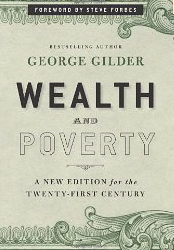 As Ronald Reagan began his first term n the White House in 1981, George Gilder released Wealth and Poverty, a book that became one of the classic defenses of supply-side economic thought. More than 30 years later, “A New Edition for the Twenty-First Century” reminds us that critics who fear the unplanned results of a free-market economy continue to pursue the same government-induced roadblocks to growth that Gilder had excoriated in his first edition.
As Ronald Reagan began his first term n the White House in 1981, George Gilder released Wealth and Poverty, a book that became one of the classic defenses of supply-side economic thought. More than 30 years later, “A New Edition for the Twenty-First Century” reminds us that critics who fear the unplanned results of a free-market economy continue to pursue the same government-induced roadblocks to growth that Gilder had excoriated in his first edition.
Readers expecting a complete update of facts and figures associated with the 1981 version of the book might be disappointed. The bulk of Gilder’s text retains references and statistics from the late 1970s. Readers should be cautious about dipping into this text for data supporting today’s supply-side arguments.
But Gilder’s approach does have at least one advantage: Readers familiar with today’s recurring attacks on free-market capitalism will have no trouble finding the same arguments dating back to the dismal closing days of the Carter era. Knowing the history of the Reagan era’s economic turnaround offers some solace that the right policies adopted today — or at least in 2013 — can reverse our present-day malaise.
Gilder sandwiches some 40 pages of “prologue” and “epilogue” around his lightly revised original text, Those chapters offer the author an opportunity to respond directly to today’s economic challenges. No one should be surprised by his focus on supply-side solutions, though some might note with interest his lack of concern about balancing the federal books.
It is perverse and self-defeating for conservatives to focus on the U.S. government’s profit and loss statement as if it were some test of fiscal virtue and path of national revival. Yes, spending on public pensions for increasingly youthful retirees and medical care with its $100 trillion long-term deficit is out of control and unsustainable. Yes, spending restraint is eminently desirable, since many government outlays distort and stultify the incentives and information flows of private-sector activity. The some $900 billion of means-tested welfare spending is destroying America’s poorer families by creating a huge incentive for indolence. But the key issues is not the spending but the corruption of the signaling systems of the economy by public sector noise of bribery and manipulation.
The avenue to national renewal runs not through changes in government accounts but through changes in federal policy, not through pursuing a balanced governmental budget but through stable, predictable public leadership without wild shifts and manipulative surprises. An almost insuperable barrier to growth is the recent coup by the Environmental Protection Agency (EPA), gaining an arbitrary right to regulate carbon dioxide across the entire economy. Applicable to anything that breathes, the EPA rules cast an unpredictable and arachnoid web over all enterprise. It is an unpredictable policy trap, promising a long series of ambushes for all new energy enterprises. A healthy public sector, by contrast, is regular, reliable, and responsible, providing a protective carrier — through the predictable, property-protecting rule of law — for the upside surprises of private-sector creativity.
The supply-side dynamic of growth begins with positive changes in policy that improve the environment for investment and innovation. Crucial are the conditions for venture capital, currently corrupted by Sarbanes-Oxley accounting rules that amount to a multi-million dollar tax or toll on any except the largest companies attempting an initial public offering. Also debauching venture investment is a full-court press of government edicts and incentives favoring inefficient and diversionary green energy projects, seducing America’s leading venturers into an unseemly queue of petitioners for government subsidies and guarantees for their products.
Written before the most recent developments in American politics, it’s interesting that Gilder’s next line labels as “a redemptive first step in changing the direction of American policy” the potential enactment of Paul Ryan’s roadmap plan for national revival.


